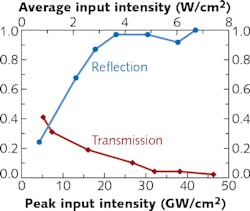Nonlinear Optics: AFRL scientists create and fabricate first reflective optical limiter

Researchers at the Air Force Research Laboratory (AFRL; Wright-Patterson Air Force Base, OH), Wyle (Dayton, OH), SelectTech Services Corporation (Centerville, OH), and Wesleyan University (Middletown, CT) have created the first optical limiter that operates primarily via reflectivity rather than absorption.1
Optical limiters are useful in some laser systems because they pass low-intensity light, but then switch off and block all light if the intensity exceeds a certain level. Such a property can be useful to prevent damage to components further along in the laser/optical system, to protect the eyes of the experimenters, or to achieve some specialized experimental effect. However, blocking high optical intensities by absorption can destroy the optical limiter itself. Thus, the AFRL reflective device is a substantial advance. (Another advantage: the reflected, rather than absorbed, high-intensity light could conceivably be used for other experimental purposes.)
Defect layer
The limiter consists of a multilayered photonic structure containing a so-called defect layer that has virtually no linear optical absorption, but a significant nonlinear optical absorption. The structure is made up of alternating amorphous silicon dioxide (SiO2) and silicon nitride (Si3N4) layers, along with a single gallium arsenide (GaAs) layer in the middle (the defect layer). (The term "defect" is used simply because, except for the defect layer, the structure is a perfect one-dimensional photonic crystal.)
Because of a resonance, the photonic structure has a high optical transmission—at least a low optical intensity. As the intensity rises, the defect layer starts to nonlinearly absorb light. However, with a further rise in intensity, the absorption in the defect layer suppresses the resonant transmission mode, causing the entire structure, which becomes two Bragg reflectors, to reflect most of the light (some light still gets through to the defect layer and is absorbed, maintaining the suppression of the transmitting resonance).
The experimental device consisted of six SiO2/Si3N4 bilayers, the GaAs defect layer, and then six Si3N4/SiO2 bilayers. The SiO2, Si3N4, and GaAs layers each had thicknesses of 264.8, 194.8, and 232.0 nm, respectively. The 232 nm thickness of the GaAs layer corresponds to a half-wave (λ/2n) thickness at a 1633 nm wavelength.
The researchers measured steady-state transmission spectra with an absorption spectrophotometer. The reflective optical limiting characteristics were measured using an optical parametric amplifier (OPA) pumped with a titanium: sapphire (Ti:sapphire) laser emitting 150 fs pulses at a 1 kHz repetition rate and a 1600 nm center wavelength as the light source, and a thermopile as the detector. The laser light was focused onto the limiter at a 6° offset angle to allow measurement.
At incident peak intensities of less than 1 GW/cm2, the device absorbed virtually no light, transmitting a large portion of it and reflecting a small amount. As the peak intensity was increased to 50 GW/cm2, the absorbed power (determined by subtracting the transmission and reflection from unity) increased, showing the nonlinear performance of the GaAs layer.
Reflection and transmission measurements were taken over a range of input peak intensities from 4.24 to 46.3 GW/cm2 (see figure). At the wavelengths of maximum resonant transmission, the transmission coefficient decreased from 0.41 to 0.026 over that peak intensity range, while the reflection coefficient increased from 0.24 to 0.98, showing that the device does indeed act as a reflective limiter. In addition, the researchers inspected the device for potential optical damage and found none.
The design of the limiter allows the input light intensity threshold above which the device begins to highly reflect to be adjusted by changing the thicknesses of the Bragg layers, say the researchers. In addition, while the experimental device operated over a band centered at 1600 nm because of the optical properties of GaAs, choosing other materials can allow other wavelength ranges.
REFERENCE
1. J. H. Vella et al., "Experimental realization of a reflective optical limiter," arXiv:1510.08028v1 [physics.optics], submitted Oct. 27, 2015; http://arxiv.org/pdf/1510.08028v1.pdf.
About the Author
John Wallace
Senior Technical Editor (1998-2022)
John Wallace was with Laser Focus World for nearly 25 years, retiring in late June 2022. He obtained a bachelor's degree in mechanical engineering and physics at Rutgers University and a master's in optical engineering at the University of Rochester. Before becoming an editor, John worked as an engineer at RCA, Exxon, Eastman Kodak, and GCA Corporation.
